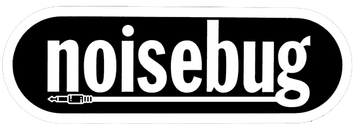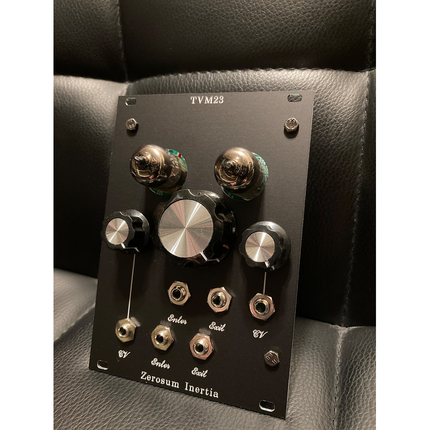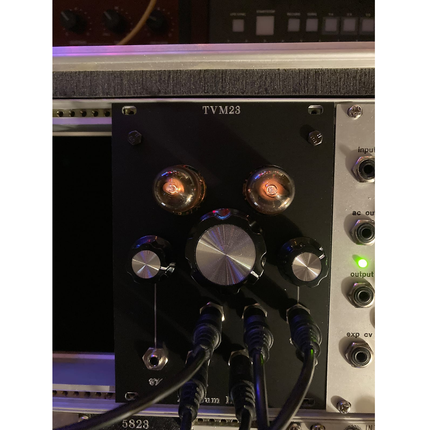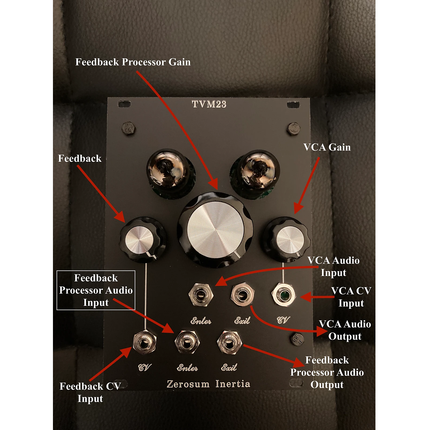Zerosum Inertia - TVM23
$525.00Excl. VAT
Description
The TVM23 is an all analog audio processor for eurorack format synthesizers.
38mm rear depth.
18HP wide.
200 mA +12 average load, 500 mA on first power up.
50 mA -12.
The TVM23 is a dual processor with two separate channels independent from each other.
The heart of both channels is a 6CB6 pentode. Two matched 6CB6 pentodes are used.
The left channel utilizes distortion and feedback to create harmonic trills and waveshaping effects.
A genuine 5C1 vactrol is used for Control Voltage of the feedback.
The bottom left row of jacks are for the left channel.
The left knob is for the feedback, the center left knob is for the gain.
This channel seems to have more obvious effects when an audio source higher in frequency is inserted.
Hit the transpose up on your sequence a few times to see what I mean.
The right channel is a loud but clean tube VCA suitable for sweetening audio signals and processing
dynamic depth.
The 6CB6 is used for both audio processing as well as Control Voltage processing for this channel.
The bottom right row of jacks is for the right channel.
The right knob is the gain control for this tube VCA.
While most “VCA” modules are Voltage Controlled Attenuators, this is a Voltage Controlled Amplifier.
Your signal will come out louder than before when patching into this channel.
The left channel greatly benefits from having attenuation before entering.
Even better is placing a VCA before it to have dynamic depth control of the waveshaping and distortion effects.
You can use the right channel for this.
But most likely you already have a traditional VCA in your system so you can use what you have for attenuation/VCA duties before entering the left channel,
then patch the left channel into the right channel for it’s gain and audio sweetening effects.
I happen to have multiple tube VCA’s so I patch a tube VCA before the left channel and after the left channel for maximum character and saturation effects.
A lot of other people do too.
Whichever VCA you choose to use before entering the left channel you will be greatly rewarded with dynamic continuously variable distortion effects as the feedback loop is always changing.
Even before you insert control voltage into the feedback amount, the feedback loop is sensitive to the amount of signal feeding it and produces unique glitchy trills that sound like a video game.
Modulate the amount of attenuation with that VCA that goes before the left channel with a random voltage, sequencer, arpeggiator, envelope, sweeping LFO or clocked rhythmic gates.
I really like the NoiseRing and Wogglebug or sequence that is feeding my oscillators for this task.
For the right channel VCA a postive control voltage source from 1-10 volts with an onboard attenuator and variable response curve is recommended. Maths works great for this.
The VCA doesn’t use an exponential VCA chip or OTA like most other VCA’s, so the response curve is not a guaranteed linear or expo response and it is different with every tube used.
That is why it best to use a modulator with a variable curve and attenuation to dial in the best response.
It is recommended to start with all the knobs at full clockwise/around 5 o’clock and then work the knobs counter clockwise as you listen to the incoming audio source.
3-5 o’clock seems to be about the sweet spot for all the knobs but you will find hidden sounds everywhere.
The center knob controls gain, so if you bring it back too far counter clockwise that will attenuate the signal completely and no sound will come out. Center knob is usually best in the 3-5’oclock range.
The left and center knobs are part of a feedback network, so the settings between the two interact and manipulate the behavior and sound of the whole left channel in a symbiotic relationship.
They both effect the pitch effects that come from the feedback sounds.

Eurorack
Eurorack is Doepfer's 3U modular format



